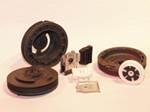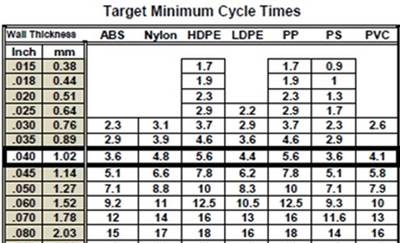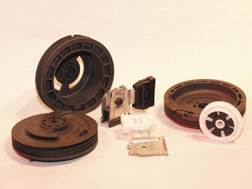7 Key Advantages of Hot Runner Systems
While both hot runner and cold runner systems have their benefits, for design flexibility as well as reduced cycle times and costs, hot runner systems will probably be the better choice.
The runnerless molding of thermoplastics is no longer new - it's been a known technology for more than 50 years, with commercial systems being available for more than 40 years. However, the growth of hot runner system sales during the last decade has been exceptional. This is a direct reflection of improved hot runner technology and of other improvements in heat control and melt-flow analysis. This growth also is a reflection of a better understanding and acceptance of the benefits of hot runner systems and their application by moldmaking companies and OEMs alike.
Today there are in excess of 40 hot runner systems suppliers as well as a number of moldmakers who design, manufacture and install their own systems in the molds they build. Current systems sales are in the hundreds of millions of dollars and it is not uncommon for the larger commercial hot runner systems suppliers to have sales approaching $50 million or more.
Not all molding applications are suitable for runnerless molding. Some materials are heat sensitive and the time-to-temperature relationship - especially when the shot size is very small - can be a problem. Some families of parts, for handling and orientation purposes, may be best kept attached to the runner until they reach another downstream operation. In other instances, the required volume of parts may be so small that the added cost of the hot runner system to the mold price cannot be justified.
Hot Runner Advantages
Although there will be an ongoing need for cold runner molds, the advantages of using hot runner systems are so great that they will increasingly be the runner technology of choice for molds used in molding thermoplastics. The key advantages are:
Elimination of the Runner
With materials becoming more sophisticated and expensive, the cold runner becomes, in turn, expensive scrap. Whether or not the runner can be reused - and in many medical and food applications they can't - regrinding and storing the runners is costly, noisy and dusty. In high-speed, high-cavitation molding operations, the scrap and regrind would be huge problems. When using hot runners, these regrind problems and their associated costs are non-existent.
Cycle Time Reduction/Lower Processing Costs
In many cases, the weight of the cold runner is up to half the total shot weight and usually much thicker in section than the molded part wall thickness. Doing away with the cold runner will reduce the cycle time since cooling time is controlled by the thickest section. In addition, there will be further cycle timesavings in the injection screw recovery and injection times because of the smaller shot size.
Improved Molding System Efficiency
Hot runner molds are generally easier to start because there aren't any solidified runners to be removed after each under-filled shot until a full mold shot is achieved and automatic cycling can begin. In hot runner systems, the mold is ready to run when the system reaches operating temperature. Also, with hot runner systems, lower injection pressures can generally be used, which will reduce mold and platen deflection and keep flash caused by mold component movement to a minimum.
Optimal Part Quality
Eliminating the cold runner will give better filling and packing conditions. When plastic is flowing through the cold runner, it loses heat to the mold plates - causing pressure drops that can result in sink marks and under-filled parts. Hot runner systems, on the other hand, maintain a balanced melt flow at a constant temperature from the machine nozzle all the way to the gate to fully fill and pack the cavities. Hot runners, therefore, help molders take full advantage of highly accurate and interchangeable cavities to achieve plastic part dimensional accuracy and quality. Should a cavity get damaged or be out of specification for whatever reason, it is very easy to reduce the heat to its hot runner nozzle and stop the cavity from producing faulty parts.
Molding Automation
An ever-increasing number of companies are automating their plastics molding and assembly. This, in turn, is driving the need for very accurate, flash-free plastic parts. Hot runner molds have a definite advantage when used with automation because, in addition to part dimensional consistency, there are no runners present to get tangled in the mold mechanisms, robots, conveyors, assembly machinery, etc.
Design Flexibility
A major hot runner advantage of which very little is written is the ability to locate the gate at a wide variety of points on the part. With the use of hot tip gating, valve gating or edge gating, hot runners allow the gate to be placed at the most favorable location for optimum filling and/or part aesthetics. This flexibility that hot runners give the part design also extends to the mold, where flexibility in gate location can help optimize cavity orientation, cooling and mold simplification.
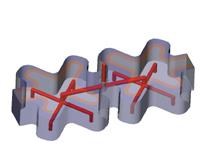
Figure 1: Balanced melt flow - a multi-level hot manifold gives equal flow and pressures to all cavities for equal filing.
Balanced Melt Flow
The flow advantage that hot runners have is that the melt channels are in separate, externally heated manifolds, which are insulated from the surrounding mold plates. Different to a cold runner plate, the hot manifold can be designed to have flow channels on multiple levels to ensure that the resin flows the same length from the molding machine nozzle to each cavity with the same channel profiles and diameters, number of turns, heat soak and pressure loss (see Figure 1). In other words, the plastic reaches each cavity - whether there are two or 96 - with the same pressure and thermal history. This designed-in temperature and pressure control is particularly favorable for resins that have narrow processing windows.
How to Choose the Right System
When the decision has been made to incorporate a hot runner system into a mold, the question arises of what to look for. With the many independent suppliers out there, the types and choices of systems are obviously numerous and often the only resemblance of one system to another is the common term "hot runner."
Hot runner technology comes with many options and the driver of selection - in order to obtain all the molding efficiencies and part quality benefits - must be the application. There are cases where price, for instance, has taken preference over the application with the consequence of lower than expected mold efficiency and sacrificed part performance.
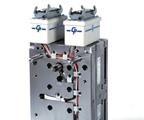
A two-cavity valve-gated hot runner bolt-on system.
- Service - In addition to sales, does the supplier offer product service, training and start-up assistance?
- Complete hot runner assemblies - Are fully assembled and tested "bolt-on systems" available or just components only, leaving the moldmaker to design and machine the surrounding hot runner plates, assemble the complete system and then test it himself?
- Product range - To achieve the optimum system for the molding application, does the supplier offer an extensive nozzle range of hot tips, valve gates, edge gates, hot sprues, multi-tips, etc. for maximum design flexibility?
- Experience - Look for a wide background in mold and molding applications. The supplier should be able to offer guidance in gate location and possible part orientation for optimum filling and packing, gate/nozzle type, gate strength and gate cooling, etc. An understanding of the relationship between the mold and the hot runner system is a critical supplier strength.
- Resin testing - Is a fully equipped resin testing or R&D facility available to assist the OEM or moldmaker in choosing the best hot runner system type, nozzles and other parameters for a new hot runner application or resin?
- Balanced resin flow - Does the supplier offer flow analysis, channel sizing and other design capabilities to produce a mechanically and thermally balanced hot runner system - a system where the runners are large enough to give a relatively small pressure drop through the system without causing too much residence time?
- Melt channels - Are the channels designed and manufactured to be smooth with rounded corners, and to have no sharp corners or "dead" spots? Can the manifold be cleaned should an incident occur which leaves the system full of degraded resin?
- Insulation - The hot runner manifold and nozzle assemblies must be insulated from the mold plates to avoid heat loss and its resulting excessive power consumption.
- Plates - Are the hot runner plates machined from solid blocks of pre-hardened stainless steel to ensure ruggedness; maximum support around the manifold; minimum deflection under high clamp tonnage and injection pressures; minimum maintenance; and hot runner longevity?
- Ease of Maintenance - Can the gates be cleaned in the machine? Can wear items such as nozzle tips, thermocouples and heater bands be replaced without removing the mold from the machine? Can the valve stems in valve-gated systems be adjusted or replaced in the molding machine?
As can be seen, the use of a hot runner system can increase overall molding efficiency by reducing cycle time, energy costs and some labor and material costs - there are no runners to regrind, store and/or scrap. Its use also adds greatly to part quality and consistency, and allows more flexibility for molding automation.
There are, however, some applications where mold or part complexity, part size or a pre-determined fixed gate location on the plastic part that may not allow direct gating with a hot runner nozzle of any type. These applications should be reviewed for using a combination of hot runner to cold runner.
A hot-to-cold runner system is simply a hot runner system of fewer nozzles feeding small balanced cold runners, which, in turn, feed the parts - say one nozzle feeding a small "x"-shaped cold runner flowing to four parts. The use of small runners considerably reduces the weight of the full cold runner and can provide a more balanced flow of resin to the cavities.
In conclusion, hot-to-cold runner systems give many of the cost and part quality advantages seen with molds incorporating full hot runners. And, incorporating a full hot runner system or a hot-to-cold runner system should be a key consideration when specifying a mold for a thermoplastic molding application.
Related Content
How to Determine the Proper Vent Depth
Vent depth is critical to optimizing mold performance, so here is one approach to finding that elusive right number.
Read MoreThe Benefits of Hand Scraping
Accuracy and flatness are two benefits of hand scraping that help improve machine loop stiffness, workpiece surface finish and component geometry.
Read MoreLine Width vs. Depth Ratio in Laser Engraving
A laser does not produce 90-degree sidewalls. It requires a certain amount of draft in order to produce the required pattern.
Read MoreThe Ins and Outs of Hot Runner Temperature Control
A training checklist that explains the why and how of proper hot runner temperature control and system management.
Read MoreRead Next
Revisiting Some Hot Runner Fundamentals
What exactly does a hot runner do? If you’ve been in the injection molding industry for any length of time, you might think the answer is obvious, but it is not.
Read MoreHow to Make an Informed Hot Runner Decision
A proper hot runner assessment requires evaluating and calculating key runner system variables.
Read MoreBenefiting From Hot Runner Design and Reliability
Selecting a hot runner system designed with the moldmaker and end user in mind has helped a moldmaking shop remain competitive.
Read More


